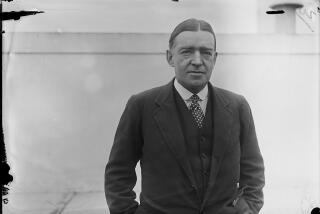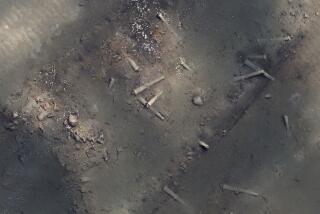Researchers Float Exhibit of Shipwreck Artifacts
- Share via
SALT LAKE CITY — Archeologists are preparing an exhibit of artifacts recovered from the wreckage of the Julia Ann, a ship that broke apart on a coral reef in 1855 while carrying a group of Mormon immigrants.
Paul Hundley, curator of the USA Gallery at the Australian National Maritime Museum, has been researching the crash for two years and told reporters recently that he believes the team has found the site where the ship ran aground.
The Julia Ann was carrying the immigrants and other passengers from Australia to San Francisco before it smashed into the reef about 400 miles from Tahiti during a violent storm on the evening of Oct. 2, 1855.
The archeologists have found an anchor, rigging, ballast and some of the 350 tons of coal the ship was transporting. The items will be displayed at the Australian museum next year and may tour Utah and the West Coast.
In the hours surrounding the wreck, two women and three children, all of whom were among the Mormon immigrants, were killed when waves washed over the ship and swept them away. Hundley said there is no indication their bodies were ever found.
The other 36 passengers, including 23 Mormons, were transported off the boat by a rope harness attached to the reef. They lived on the nearby island of Scilly for two months, before the crew could repair the ship’s rowboat to make the three-day, 250-mile journey to Bora Bora for help.
The crew returned with a rescue boat that took the remaining passengers to Tahiti, where they stayed for up to a year. Some conducted missionary work among the natives.
Eventually, they made their way to San Francisco and, with the exception of one family, moved on to Utah--their original destination. Hundley estimates 18 of the original 28 passengers eventually moved to Utah.
He said most of the passengers were papermakers, millers and farmers.
Hundley--who has searched through wreckage of more than a dozen ships, mostly in the United States--first became interested in the Julia Ann wreck two years ago when a rare-book dealer came across a copy of “Narrative of the Wreck of the Barque Julia Ann.” The book consists of letters and journal entries by Capt. Benjamin Franklin Pond during the stay on the island.
Hundley hopes to return to the site to investigate reports that a large part of the ship had been found by an earlier expedition in shallower water around the reef.
“There’s a possibility that there’s 45 feet of the ship that has timber, cargo, coal and possibly personal possessions in the area we haven’t surveyed,” he said.
Initially, Hundley was fascinated by the historical and commercial importance of the Julia Ann, but soon his interest turned to the Mormons’ migration.
“It’s important because the Julia Ann played a significant role in the Australian-American relationship,” he said. “It was a very exciting period of time of the California gold rush followed by the Australian gold rush. It was boom times on both sides of the Pacific.”
More to Read
Sign up for Essential California
The most important California stories and recommendations in your inbox every morning.
You may occasionally receive promotional content from the Los Angeles Times.










